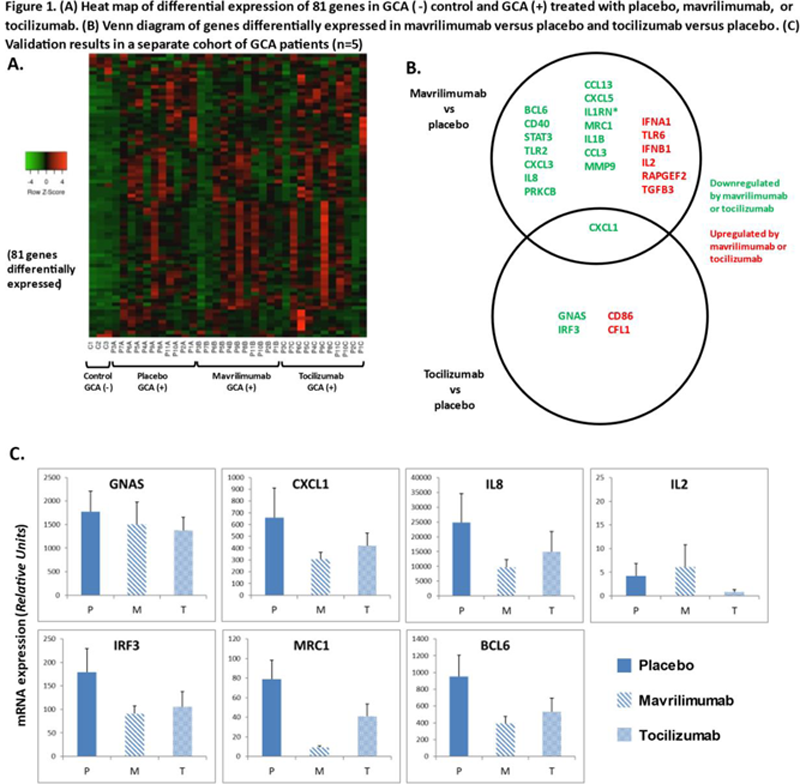

Background: Giant cell arteritis (GCA) is a chronic disease, and affected patients suffer from relapses and glucocorticoid (GC)-related toxicity. Targeted therapies are emerging with the aim of achieving better disease control and reducing GC exposure. Blocking IL-6 receptor with tocilizumab has been a major advance in the treatment of GCA. However, approximately 40% of patients treated with tocilizumab in combination with GCs experience a flare or tocilizumab-related adverse event. Blocking GM-CSF receptor α with mavrilimumab significantly reduced risk of relapse and improved sustained remission at week 26 vs placebo in a Phase 2 trial. Not all patients satisfactorily respond to any therapy, indicating heterogeneity in leading pathogenic pathways among patients. For these reasons, it is crucial to understand the specific impact of targeted therapies on vascular lesions.
Objectives: In this study we investigated transcriptomic changes induced by tocilizumab or mavrilimumab in ex-vivo cultured arteries from patients with GCA.
Methods: Temporal artery sections obtained for diagnostic purposes from 11 patients with histopathologically-confirmed GCA and 3 controls were cultured ex-vivo and exposed to placebo, mavrilimumab, or tocilizumab (both at 20 µg/mL) for 5 days. Of 11 GCA donors, 2 had received no treatment prior to biopsy, 2 had received a single prednisone (60 mg) dose, 1 had received 2 daily doses, and the remaining 6 had extended treatment; in prednisone-treated patients, mean (SEM) treatment duration was 17.9 ±8.7 days. A separate cohort of patients (consisting of five newly diagnosed patients with GCA, age- and sex-matched with the previous cohort) was used to validate 7 transcripts by real time PCR. Genes were selected for validation based on high level of expression and differential expression with each treatment. All samples were homogenized, and total RNA was extracted with TRIzol reagent. 100 ng of RNA per sample were processed with Nanostring Inflammation gene expression assay (256 transcripts) and hybridized using nCounter Prep Station. Barcode counts from nCounter Digital Analyzer were processed with nSolver 4.0 Software. Normalised data were analyzed using R Studio 4.0.5 and IBM SPSS 22.0, and paired Wilcoxon tests were applied individually to each treatment comparison group for each analysed gene. One µg of RNA per sample from the validation cohort was retrotranscribed; subsequent real time PCRs were normalised against endogenous control GUSb and analysed using SDS 2.3 software.
Results: 67 out of 250 transcripts were differentially expressed between arteries from GCA patients and arteries from control patients (all placebo-treated). Of those, only 9 transcripts remained significant after correction for multiple comparisons, with a false discovery rate ≤0.05. 81 transcripts were differentially expressed in at least one comparison across groups (

Conclusion: Mavrilimumab and tocilizumab have a different transcriptomic impact on cultured arteries from patients with GCA, with some overlapping effects, although differential effects may have been attenuated by prior GC use. A better understanding of the impact of targeted therapies on vascular inflammation is needed to improve treatment options for patients with GCA.
Acknowledgements: The authors would like to thank: the Genomics core facility of the Institut d’Investigacions Biomèdiques August Pi i Sunyer (IDIBAPS) and Emily Plummer, PhD, Kiniksa Pharmaceuticals, for her invaluable contribution.
The study was funded by Kiniksa Pharmaceuticals, Ltd. With support from: Fundació Clínic Barcelona, Fundació Privada Cellex, IDIBAPS, Universitat de Barcelona, Vasculitis Foundation, Marie Curie Actions, and Gobierno de España, Ministerio de Economía, Industria, y Competitividad.
Disclosure of Interests: Marc Corbera-Bellalta: None declared, Farah Kamberovic: None declared, Ferran Araujo: None declared, Roser Alba-Rovira: None declared, Georgina Espigol-Frigole Consultant of: Consulting for Janssen and Hoffmann-La Roche;, Grant/research support from: Meeting attendance support from Boehringer Ingelheim, Marco Alba: None declared, Sergio Prieto-González Speakers bureau: Lecturing for Roche, Grant/research support from: Meeting attendance support from Italfarmo and CSL Behring, José Hernández-Rodríguez Speakers bureau: Lecturing for Novartis, Consultant of: Consulting for Sobi, Grant/research support from: Meeting attendance support from Sobi and Novartis, Patricia Pérez-Galán: None declared, Kent Bondensgaard Shareholder of: Kiniksa Pharmaceuticals Corp., Employee of: Kiniksa Pharmaceuticals Corp., John F. Paolini Shareholder of: Kiniksa Pharmaceuticals Corp., Employee of: Kiniksa Pharmaceuticals Corp., Maria C. Cid Speakers bureau: Educational from GSK and Vifor, Consultant of: Consulting for Janssen, GSK, and Abbvie, Grant/research support from: Research grant from Kiniksa; meeting attendance support from Roche and Kiniksa